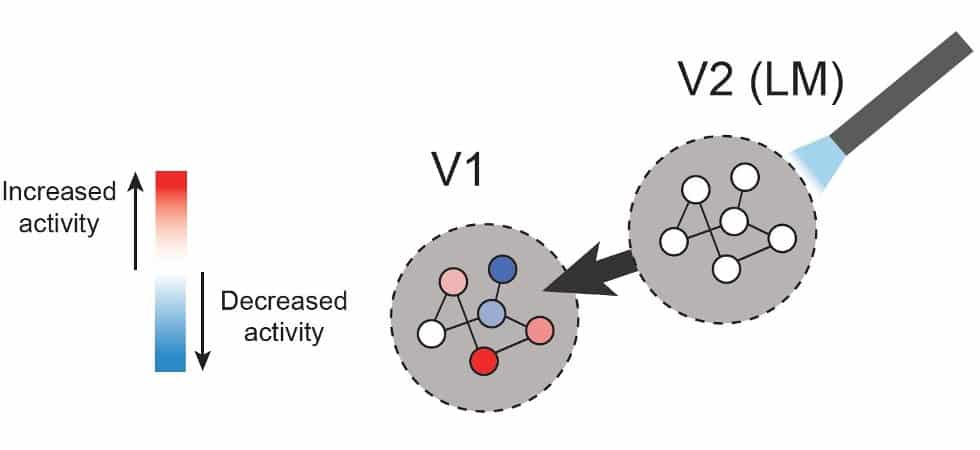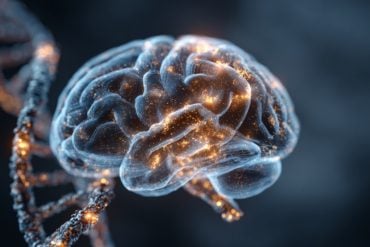Summary: Researchers identified how the primary visual cortex and the lateromedial area of the cerebral cortex influence one another, and how this communication changes over rapid timespans.
Source: Sainsbury Wellcome Center
Understanding how brain areas communicate is one of the oldest questions in neuroscience. Researchers at the Sainsbury Wellcome Centre at UCL used causal techniques to uncover how two neocortical areas in the brain communicate with one another and found that their influence on each other changes over much faster timescales than previously thought.
With around 80 billion neurons and 100 trillion connections in the brain, it has been challenging for neuroscientists to untangle the networks that give rise to behavior.
In a new study, published today in Neuron, SWC researchers elucidate how two visual areas in the cerebral cortex, the primary visual cortex (V1) and lateromedial area (LM), influence one another and how this communication changes over rapid timespans.
“We wanted to study the communication between areas to understand how different brain regions work together to process visual stimuli. From classical studies, we know that there is a hierarchy of visual areas with feedforward and feedback pathways. The first level of hierarchy in the cerebral cortex is V1 and the second level is V2 in primates, the equivalent of which is LM in mice,” said Mitra Javadzadeh, Research Fellow at SWC and co-author on the paper.
“Our expectation from the anatomical connections between V1 and LM is that the effect of neuronal activity in one area on another would be relatively constant; however, we were surprised to find it is dynamic and changes over time. These changes can happen very rapidly, within tens of milliseconds,” said Sonja Hofer, Group Leader at SWC and co-author on the paper.
Historically, scientists have recorded from different brain areas and used statistical correlations to infer how one area influences another. In this study, Javadzadeh and Hofer instead took a causal approach by using neuronal perturbations to study the dynamics of inter-areal interactions over time.

The neuroscientists recorded from populations of neurons in V1 and LM in mice and used optogenetics to briefly silence the activity of one area and quantify how the activity increased or decreased in the other area. This showed them the contribution of the first area in shaping the firing rates of the second area.
Javadzadeh and Hofer measured these contributions over time while these brain areas were processing visual information.
Surprisingly, they found that the effect of manipulating one area on the activity in another varied over time on a fast timescale. For example, a neuron in area V1 could decrease its activity in response to area LM at one time point but not be influenced by LM activity 100 milliseconds later.
Furthermore, if the visual stimulus was behaviorally relevant for the animal, for example if it was predicting the occurrence of a reward, then these changes in influence occurred even faster.
The function of these rapidly changing influences is not yet known, but the authors hypothesize that they may allow cortical areas to control different aspects of processing in the downstream brain regions they influence over very short time spans. This would mean that the role individual areas play in shaping each other’s activity could be flexible and tailored to the dynamic demands of behavior.
In addition to exploring the function of these dynamic interactions, Javadzadeh and Hofer are working together with scientists at the Gatsby Computational Neuroscience Unit, located within the same building as SWC, to understand the mechanisms by which they come about.
About this neuroscience research news
Author: Press Office
Source: Sainsbury Wellcome Center
Contact: Press Office – Sainsbury Wellcome Center
Image: The image is credited to Sainsbury Wellcome Center
Original Research: Open access.
“Dynamic causal communication channels between neocortical areas” by Mitra Javadzadeh et al. Neuron
Abstract
Dynamic causal communication channels between neocortical areas
Highlights
- Optogenetic perturbations reveal the causal structure of long-range cortical influences
- How visual areas influence each other changes dynamically over tens of milliseconds
- Feedback to V1 improves visual stimulus encoding required for behavior
- The dynamics of feedback influences depend on the behavioral context
Summary
Processing of sensory information depends on the interactions between hierarchically connected neocortical regions, but it remains unclear how the activity in one area causally influences the activity dynamics in another and how rapidly such interactions change with time.
Here, we show that the communication between the primary visual cortex (V1) and high-order visual area LM is context-dependent and surprisingly dynamic over time.
By momentarily silencing one area while recording activity in the other, we find that both areas reliably affected changing subpopulations of target neurons within one hundred milliseconds while mice observed a visual stimulus.
The influence of LM feedback on V1 responses became even more dynamic when the visual stimuli predicted a reward, causing fast changes in the geometry of V1 population activity and affecting stimulus coding in a context-dependent manner.
Therefore, the functional interactions between cortical areas are not static but unfold through rapidly shifting communication subspaces whose dynamics depend on context when processing sensory information.






